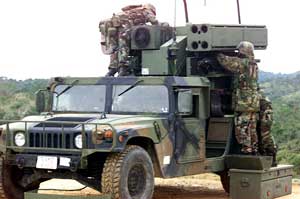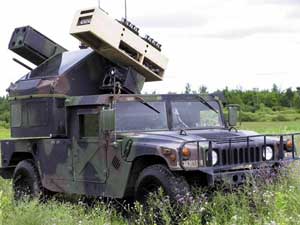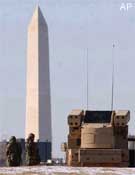|
The Avenger Pedestal Mounted Stinger system
is a lightweight, mobile and transportable surface-to-air
missile and gun weapon system, mounted on a Heavy High
Mobility Multipurpose Wheeled Vehicle (HMMWV). Avenger is
designed to counter hostile cruise missiles, unmanned
aerial vehicles, and low-flying, high-speed, fixed-wing
aircraft and helicopters attacking or transiting friendly
airspace. The Avenger, manufactured by Boeing in
Huntsville, is a shoot-on-the-move, totally automated,
day-and-night capable short-range air defense system. A
key element of the Army's Forward Area Air Defense System,
Avenger was deployed during Operation Desert Storm and is
currently deployed in the Balkans.
 Avenger
fills the Line of Sight-Rear (LOS-R) portion of the
Forward Area Air Defense System (FAADS). It has a two man
crew and can operate in day or night, clear or adverse
weather conditions. The system incorporates an operator's
position with displays, fire control electronics, and the
Standard Vehicle Mounted Launcher (SVML). The SVML
supports and launches multiple Stinger missiles (Basic
Stinger, Stinger-POST (Passive Optical Seeker Technique),
or Stinger-RMP (Reprogrammable MicroProcessor).
Additionally, the SVML incorporates a .50 caliber machine
gun and necessary fire control sensors for both weapons.
The contribution this highly mobile, short range air
defense system makes to the Army's full-dimensional
protection enhances the ground components prospects for
dominant maneuver by preserving key elements of the force. Avenger
fills the Line of Sight-Rear (LOS-R) portion of the
Forward Area Air Defense System (FAADS). It has a two man
crew and can operate in day or night, clear or adverse
weather conditions. The system incorporates an operator's
position with displays, fire control electronics, and the
Standard Vehicle Mounted Launcher (SVML). The SVML
supports and launches multiple Stinger missiles (Basic
Stinger, Stinger-POST (Passive Optical Seeker Technique),
or Stinger-RMP (Reprogrammable MicroProcessor).
Additionally, the SVML incorporates a .50 caliber machine
gun and necessary fire control sensors for both weapons.
The contribution this highly mobile, short range air
defense system makes to the Army's full-dimensional
protection enhances the ground components prospects for
dominant maneuver by preserving key elements of the force.
The Avenger weapon system includes a
360°, rotating turret mounted on a heavy HMMWV chassis
with an upgraded suspension and 200 amp alternator. The
baseline configuration consists of a gunner's turret with
missile pods mounted on each side. Each missile pod,
called the standard vehicle-mounted launcher, can hold
four missiles that can be removed and fired in the MANPAD
employment configuration. The rotation of the turret and
the elevation of the standard vehicle-mounted launcher is
accomplished by electric motors powered by batteries
carried in the base of the weapons system. The vehicle's
power system is in parallel with the Avenger battery set.
The .50 caliber machine gun affords a measure of
self-protection by providing additional coverage of the
Stinger missile's inner launch boundary.
 The
Avenger weapons system has an unobstructed, 360° field of
fire and can engage at elevations between -10 and +70°.
The modular design of Avenger allows complementary
missiles and/or rockets to be installed on the launch arms
in addition to (or in place of) Stinger missiles. The
gunner has sufficient visibility out of the turret for
visual target acquisition, tracking, and engagement. A
combination glass sight is used through which the gunner
looks to aim the missiles and on which a driven reticle
display is projected. The driven reticle indicates the
aiming point of the missile seeker to confirm to the
gunner that the missile seeker is locked onto the desired
target. The
Avenger weapons system has an unobstructed, 360° field of
fire and can engage at elevations between -10 and +70°.
The modular design of Avenger allows complementary
missiles and/or rockets to be installed on the launch arms
in addition to (or in place of) Stinger missiles. The
gunner has sufficient visibility out of the turret for
visual target acquisition, tracking, and engagement. A
combination glass sight is used through which the gunner
looks to aim the missiles and on which a driven reticle
display is projected. The driven reticle indicates the
aiming point of the missile seeker to confirm to the
gunner that the missile seeker is locked onto the desired
target.
Avenger's sensor package includes a
forward-looking, infrared (FLIR), carbon dioxide, eye-safe
laser range finder and a video autotracker. These sensors
provide Avenger with a target acquisition capability in
battlefield obscuration at night and in adverse weather.
Range data from the laser range finder is processed by the
Avenger fire control system to provide a fire permit for
missile and gun use. A driven reticle and other data are
displayed on the forward-looking infrared display in the
same manner as the optical sight.
The turret drive is gyro-stabilized to
automatically maintain the missile pod aiming direction
regardless of the vehicle motion. The turret drive control
is operated by the gunner with a hand controller on which
the missile and gun controls are placed. The gunner can
transfer tracking control to an automatic turret drive
control system that uses signals for the uncaged missile
seeker of the FLIR video autotracker to track the target
until the gunner is ready to fire. The firing sequence is
entirely automated, including superelevation and lead, so
that the gunner need merely push the fire button to
initiate the fire sequence and immediately select and
prepare the next missile for firing. These systems enable
Avenger to accurately and rapidly launch missiles.
 Avenger
is equipped with two VHF-FM frequency-hopping radios
(i.e., SINCGARS) and an integrated remote terminal unit.
When this capability is tied into the Marine air command
and control system, Avenger can be configured to
automatically slew to a target that appears on the radar
display. This capability is known as "slew to cue."
Targets pointed out by ground-based air defense units,
tactical air operations center operators, or the LAAD
section leader can be accepted or rejected by the gunner.
Until the gunner responds to the cue, the gunner maintains
complete control of the Avenger turret. If the gunner
accepts a pointer, the turret automatically slews to the
azimuth of the target. The gunner then resumes control of
the turret and completes the engagement process by
acquiring, tracking, and engaging the target. "Slew to
cue" is a capability inherent to any radar picture. Avenger
is equipped with two VHF-FM frequency-hopping radios
(i.e., SINCGARS) and an integrated remote terminal unit.
When this capability is tied into the Marine air command
and control system, Avenger can be configured to
automatically slew to a target that appears on the radar
display. This capability is known as "slew to cue."
Targets pointed out by ground-based air defense units,
tactical air operations center operators, or the LAAD
section leader can be accepted or rejected by the gunner.
Until the gunner responds to the cue, the gunner maintains
complete control of the Avenger turret. If the gunner
accepts a pointer, the turret automatically slews to the
azimuth of the target. The gunner then resumes control of
the turret and completes the engagement process by
acquiring, tracking, and engaging the target. "Slew to
cue" is a capability inherent to any radar picture.
Avenger completed a two phase IOT&E in
1989. Phase I consisted of acquisition and tracking trials
at Fort Hunter-Liggett. Phase II consisted of Stinger
missile firings at White Sands Missile Range. The Avenger
system was found to be operationally effective by DOT&E in
the B-LRIP to Congress dated February 28, 1990. Avenger
was found to be operationally suitable with some limiting
factors. These limiting factors were: back blast damage to
the cab at some firing azimuths and elevations; excessive
hydrogen chloride gas levels in the cab; need for a
improved voltage regulator; and the need for an
environmental control unit/ primary power unit (ECU/PPU)
for the gunner's cupola.
The Army reports that they have
corrected the limiting factors. Prior to fielding, Boeing
reinforced the vehicle doors to prevent back blast damage.
Also, cab openings and doors received new seals or gaskets
to reduce the HCL gas levels. A retrofit was performed to
address the voltage regulator problem. A redesigned
regulator and a larger alternator were installed on all
fielded vehicles, while the new items were cut into
production.
An ECU/PPU design was tested and found
to address the heat build-up in the cupola. During
testing, the ECU/PPU was found to create an EMI problem
with the Forward Looking Infrared (FLIR) and the Radar
Control Unit Video. Before fixes could be incorporated,
the SBA contracted firm producing the ECU went bankrupt.
An alternate source was identified when another firm
purchased the defaulter. Fixes have been explored as part
of the contract restart. A follow-on test was completed by
Redstone Technical Test Center to verify ECU/PPU
performance and compatibility. First production units have
been accepted.
The new ECU/PPU underwent environmental
testing at RTTC, Huntsville. Since the testing used a
fixture, not the system, the testing did not provide
sufficient operational data needed by OPTEC and DOT&E to
provide an adequate evaluation of this issue.
OPTEC (OEC) is working with the PM to
plan an ECU/PPU environmental test which satisfies the
data requirements for the operational evaluators. The test
and evaluation of the Avenger in accordance with the DOT&E
approved TEMP dated 20 June 1987 will conclude once the
ECU/PPU limiting factors outlined in the B-LRIP dated 28
February 1990 have been adequately addressed. Army testing
of alternate source ECUs will examine the following
questions: (1) Does the ECU cool the gunner's turret in
extreme temperatures? (2) Is the ECU reliable? (3) Are
there any safety problems with the ECU? (4) Does the ECU
degrade the operational capabilities of the Avenger, for
example, the range of the SINCGARS radios? Technical
testing to date has addressed these questions, however the
Army has yet to test a "production representative" item.
When Army technical testing is complete, data will be
provided to OPTEC and DOT&E for review and assessment.
When the B-LRIP limiting factors have been completely
addressed, Avenger will be dropped from DOT&E oversight.
The AVENGER is operated by a two-man
crew. The gunner operates from inside the turret, and the
driver operates from the driver's compartment. The health
hazard assessment identified heat stress as a potential
health hazard. Testing indicated that both the gunner and
driver became uncomfortably hot following 60 minutes of
firing when the outside temperatures near 85¡F. When the
gunner and driver operated in Mission-Oriented Protective
Posture (MOPP), significantly higher heat loads were
observed. Actual firing missions for the AVENGER may last
up to 12 hours, and the associated heat loads on the
gunner and driver may be well in excess of acceptable
levels. The health hazard assessment report recommended
installation of a cooling system at all crew positions.
In early 1999 the Army exercised a $14.6
million option on future production of an upgrade kit for
Avenger air defense units that will greatly increased
their effectiveness beginning 1st Qtr FY00. The
Slew-To-Cue (STC) subsystem, a major upgrade enhancement
to the Avenger, is expected to improve Avenger's target
acquisition, tracking and engagement range by about 50
percent while increasing the number of engagements and
kills by more than 50 percent. The system will also
significantly improve Avenger's battlespace performance.
Using STC, the Avenger will be able to accept digital
early warning data and automatically slew the turret in
both azimuth and elevation, centering the target in the
gunner's field of view. Targeting data is provided by
Forward Area Air Defense (FAAD) Command, Control,
Communications and Intelligence (C3I). The FAAD C3I
equipment provides early warning/alerting, a complete air
picture, slew-to-cue and target IFF information. This
improvement not only improves the efficiency and
effectiveness of the Avenger, but also allows it to kill
the broadening spectrum of 21st century threats, including
CMs and UAVs. The $14.6 million contract is for low-rate
initial production, full production, contractor logistic
support for approximately 100 Avenger fire units. |